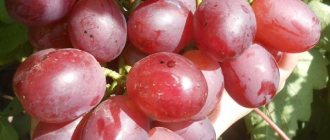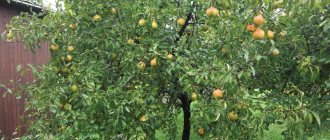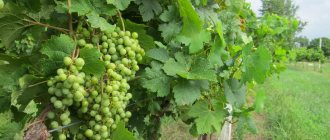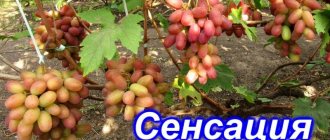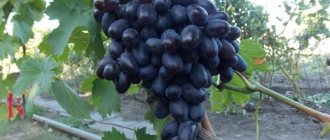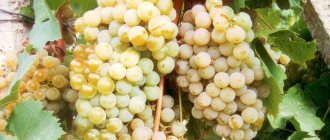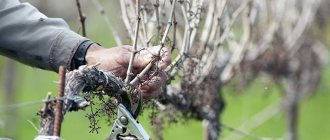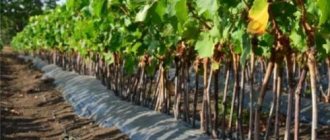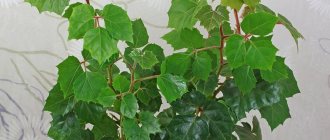Advantages and disadvantages
Pros:
- High frost resistance (up to -30ºС).
- No seeds inside the berries.
- Stable and good yield.
- Excellent presentation.
- Easy to care for.
- Early ripening of berries.
- Versatility in use.
Minuses:
- Tendency to peas.
- Sometimes rudiments are found in the berries.
- The plant requires annual pruning and crop rationing.
Origin
Parents of the grapes “in memory of Dombrovskaya” are “dawn of the north” and “universal raisin”
The author of the variety is the Orenburg breeder Fedor Ilyich Shatilov, who successfully crossed the “dawn of the north” and “universal raisin” grapes back in 1983. From its “parents” the new variety received the properties to withstand low temperatures, produce a decent harvest, and also have a sweet, pleasant taste.
This grape received its name only in 1990: it was named in honor of Yana Adamovna Dombkovskaya, an employee of the breeding station, who suddenly died. In the same year, the variety was entered into the State Register under a new name.
Main characteristics
The variety “in memory of Dombkowska” is an early seedless grape variety created for cultivation in the northern regions, good for making juice and wine.
Ripening period
The variety is considered early because the growing season lasts 115–120 days. Harvesting can begin in late August or early September, depending on the region of cultivation.
Bush
The grape bush “in memory of Dombkowska” is fast-growing, strong and strong. The vine is capable of growing 5 meters over the summer, ripening along its entire length, regardless of weather conditions.
The leaves are three-lobed, dark green, slightly pubescent and have long petioles.
The flowers are bisexual, which allows the formation of an ovary without additional pollination.
Bunches and berries
The shape of the brushes of this variety is cylindrical or conical. The size of the bunches is average, weight - from 300 grams to 1 kilogram. This variation depends on the number of brushes on the shoot: the more there are, the smaller they are. The density of berries in the cluster is high.
The oblong berries weigh, on average, 2–3 grams. The skin is dark blue, almost black with a slight coating of pruin. The peel is dense, but does not cause discomfort when chewing the berries. Beneath it lies pink juicy pulp, which contains up to 22% sugar and 10 g/l acid.
Reference! “In Memory of Dombkowska” is a variety of raisins, so there are no seeds inside the pulp; sometimes small rudiments can be found.
Taste
The taste of the berries is pleasant, it perfectly combines sweetness and light sourness.
Productivity
Eyewitnesses testify that with properly organized care, 12 to 20 kg of fruit can be removed from one “memory of Dombkowska” bush.
Description of culture
The grape bushes are developed and powerful in structure. During the warm period, the vine manages to grow up to five meters. The bark is light brown, smooth. The leaves are green, carved, three-fingered with prominent veins. They have long cuttings. On the inside they are pubescent. The pubescence is light, reminiscent of a cobweb.
The flowers are bisexual and delicate. The plant does not require additional pollination. The fruits are large, round in shape, blue-black in color. The top is covered with a thin layer of whitish wax. The berries have a sweet and sour taste. The amount of sucrose in them in especially sunny and warm summers reaches 20%.
The skin on the fruit is dense. Withstands any weather. When exposed to moisture, it is well preserved and does not burst. The pulp is lilac in color, dense and crunchy. There are no bones in it at all. But sometimes there are soft inclusions.
The clusters are beautiful, cone-shaped, medium loose. If three clusters were left during pruning, the weight of one is about 400-700 g. If there is one bunch on the bush, its weight in a fruitful summer is up to one kilogram.
Application and beneficial properties
The “Pamyatie Dombkowska” variety is considered a table raisin, its use is universal. From sweet seedless berries you can prepare compote, preserves and jam, squeeze juice, and make wine. These grapes are also used in baked goods and desserts. You can eat berries fresh. It is worth noting other good raisin varieties: “Hungarian”, “Century”, “Veles”.
Dense bunches of grapes “in memory of Dombrovskaya”
Varieties of sultanas, including “in memory of Dombkowska,” can be easily included in the diet , since the chemical composition of the pulp and peel has a beneficial effect on the state of the gastrointestinal tract, cardiovascular and nervous systems.
- A wide range of vitamins, micro- and macroelements will help strengthen the immune system and combat irritability and fatigue.
- Potassium regulates heart function, and vitamin C strengthens blood vessels and the immune system.
- Folic acid, iron and B vitamins improve blood composition, preventing the development of anemia.
- Oleanolic acid in berries is an anti-inflammatory substance, which is very important for inflammatory diseases of the oral cavity, gastritis, and intestinal inflammation. It is also very useful for diseases of the urinary system.
- Calcium, magnesium and phosphorus will strengthen bone tissue, which is important in the prevention of osteoporosis, arthritis, and arthrosis.
Grapes can easily satisfy your hunger, because the calorie content of 100 g of the product is about 100 kcal.
Comparison with analogues
In the table below you can see the main comparative characteristics of the “Pamyat Dombkowska” variety and some of the best black sultana grape varieties.
| Sign | Variety | |||
| In memory of Dombkowska | Attica | Jupiter | Autumn Royal | |
| Ripening period | 115 – 120 days | 115 - 120 days | 110 – 125 days | 135 – 145 days |
| Frost resistance | -30C | — 23C | -29C | -20C |
| Productivity | From 12 kg to 20 kg | 15 – 20 kg | Up to 30 kg | Up to 15 kg |
| Bunches | From 300 g to 1 kg | From 700 g to 2 kg | 250 – 500 g | 700 g – 2 kg |
| Taste | Sweet taste with slight sourness | Fruity notes | Notes of nutmeg and strawberry | Harmonious simple |
| Color | Issinya - black | Deep purple | Dark blue | Dark purple |
| Disease resistance | Average | Average | Above average | Above average |
| Shelf life | Up to 2 months | Up to 2 months | 3 – 4 months | 3 – 4 months |
| Sugar accumulation | 20% | 16 – 19% | 22% | 16 – 18% |
| Acidity | 10 g/l | 5 g/l | 4 – 6 g/l | 7 – 9 g/l |
Forum statistics
207036 Messages in 1634 Topics from 5593 Users. Last user: Amaya Last message: “Let's talk about the weather in Vash...” ( Today at 07:52:22 ) Latest messages on the forum.
Now on the forum
37 Guests, 12 Users
Users in the last 15 minutes: 64nikolay64, zsb, GALINA ANOKHINA, Polina77, Yura, spotlight, Mikhail Alekseevich, Svetla777, Tihiy, Marshal, Nikolay S., therapist [Blocked] [Section Moderator] [Forum Moderator]
Maximum online today: 77 . All-time maximum online: 2758 (28 July 2021, 17:22:51)
Users who visited the forum in the last 24 hours
Total: 293
(Visible: 292, Hidden: 1) 1963, 64nikolay64, zsb, GALINA ANOKHINA, Polina77, Yura, spotlight, Mikhail Alekseevich, Svetla777, Quiet, Marshal, Nikolay S., therapist, Liza, Capricorn, lomakin1969, Alexander Vl., Elvira2017 , Andrey76, Slavka, Mikhail77, ElenkaF, Tatyana B, Alex65, Cherkessk, Eugene, leonidych, vladimirM, yotmast, mers, Serg1707, SNovichek, hanter64, znakomij, Alexander K, Vardan, Sergey Fer, Anatoly Sivkov, Alexey V, Ilya 77 , Andrey Gladilin, Tatyana A., Belgorodets, in Astrakhan, Oksana Kopp, sem_en, Vladimir 153, skier, Igor Viktorovich, slavalimon, Primorets, OlgaOs, SANYCH, 31rus, mystic69, DorontsovPeter, Andrey Tsvetkov, Buba, igor222, Elena Z, vlad51, Kenig, Nikolay Rex, Sergey 1965, Vladimir Buturlakin, DSW, psv1960, Dmitry 77, Vasily V., Vyacheslav03, Natalia Nikolaevna, Sergey Tashchiyan, Igor Sergeevich, alexsandr, kvg, Pioneer, Ekaterina Polyanina, nicson7, Elena Aleshchenko, Alexander -ask-34, Verona, Igor F., Taker, Henry, Yuri72, L.A.P., Gaivoronsky Yuri, Sergeevich, Sergei Chistokletov, Svetlana Streletskaya, Galinka, Alexey Deminov, Naumov Igor, Vyacheslav136, Gloomy, Katrin, AndSanych , Mikhno Alexander, Ded31, Filippov Oleg, Vladimir ++, Lydia58, ALEXANDER BRYANSKY, Vladimir-kanevskaya, DIL, Amber7394, Marina Protasova, TITOVA LYUBOV, Linx, alexander66, Natalya M, Mikhail Fesenko, Amaya, Alexander71, Boris 1952, tsv , Maximilian, 25nata35, nadia, Igor_K, Alexander Kolesnikov, Ivan Levin, Pitko, weather forecaster, eSAa, cecet71, atseton, Alexander Smirnov, Vladimir Kostochkin, Vladimir Berdnikov, Gocha, pioneer-2, LeXa_KoT, Sergey 61, Sergey Yuryev, Erem, alexss, Evgeniy52, Skif, Vladimir Kovba, dayton, Yuri Semenov, N.A. Sokolov, Pavlentiy, Sa-shura, Volgogradka, Dmitry Anatolyevich, Grandfather Igor, Andrey Lis, Bublichenko Alexander M, Marina Krymskaya, stenlly2010, irahelm, Vyacheslav Vladimirovich , Vladimir Shilov, Aprel, Dmitry Badaev, gheo55, y_fed, rambo, Yagodka, Valentina Ivanovna, Kryn, oleg9f, DED2, Svetlana Korotina, Oleg Ivanovich Zavezen, Eduard., santra, L2k2m7n, Alexander48, Viknik, Andrey 31, m2d, Valery Rastorguev, Soshnin Yura, Gardener - amateur, Galina, Vasily1111, gardener, marlin64, Salex, sergei, Sergey Ko, Ramiz, Victor_, kosmos, potap05, Yuri 36, VitalySD, Inna161, Vova Kapran, Vladimir Shcherbinin, Valerie, niy1, cfibr , Andrey68, kulol3, thanatos, Serzh1978, Realist, Artur53, max2008-01, LOZA, AlexanderD, Grandfather Young, Natasha, Zayac, ketch, Rita, alx-74, Iv Iv, Alexander150, Igor K, Vasily Viktorovich, VeraNiK, kdm57 , Veniaminovich, Boris Sokolyansky, 77volt, , vikbublik, neposny, Evgen, Victoria Aleksandrovna, Serezha 64, Wintel, Airbone, teri, Sergey Lomonosov, Khramov, serginio, Leonty Yarygin, Irina O., Ser, Nadezhda Grig, Lyubov S., netolya, Saisan, Alexey Agryzkov, Vadi, Zinaida, Vadim, Alexander Taganrog, Sergey Sukhonos, Snezhinets, evgen_26, nau_63, Masha_sadovod, Gennady163, krasnovlad1, Alexander Zinoviev, Vasily 53, Roman Fedorovich, TIS, Alexey Sergeevich, arnyusha, Zheka, Nurtas , kradievska, nick041, Valentina Medvedeva, Sergey43, Andrey S., Nikolay Lipunov, Mst, Vertuoz2, Vladimir VS, NatalyaMed, freesia, Kinna, Mikhail Michurinsk, alekcsan1, VALERY TAMB, Sasha57, MikhAf, Y_Azer, Andrey Beribesov, hunter1955, amateur nuts, Keys, Ivan Shmelev, Pestle, anton_slash, Nadymchanka, Sergey 31, Volgar, Pavel 64, Tatyana Volzh, Elektronik_t, Alexander 61, Alexander Gai
Features of cultivation
“In Memory of Dombkowska” was created specifically for cultivation in the North, so it can withstand very low temperatures.
Landing
ChBZ planting is carried out both in autumn and spring. Spring work begins in the second half of April - early May, when the danger of return frosts has completely passed. Autumn planting begins in mid-September, the main thing is to do it before the first frost.
Reference! In the spring, you can begin planting work when a stable air temperature has established at +15ºС, and the soil has warmed up to +10ºС.
Place and soil
BChZ thrives in black soil or loam; dense soils do not give it the opportunity to fully develop. The main conditions for the place of future growth are plenty of sun and calm from wind and drafts. If there are many buildings on a personal plot, then the plant bushes should be located at a distance of 5.5 - 6.5 m from them. And also - the absence of groundwater close to the soil surface. The soil must have a pH of 7, that is, be acid neutral. You can learn about the ideal place and soil for grapes from separate articles.
The depth of the planting hole should be 1.5 m, its bottom must be covered with drainage. The next layer is peat or humus, a little ordinary soil. The plant is placed in a hole, all its roots are carefully straightened and carefully covered with earth. The surface of the soil is compacted to securely fix the seedling, which must be watered abundantly. Experienced winegrowers recommend immediately after planting to cover the ground around the young plant with mulch of freshly cut grass. This measure will help reduce the rate of moisture evaporation, as well as prevent the random growth of weeds. In addition, rotting greens are an additional fertilizer for grapes.
Reference ! The first harvest of the “Pamyatie Dombkowska” variety is usually obtained in the third year of cultivation, and in 5 years its volume increases significantly.
Watering and fertilizing
Young grape bushes should be watered 2 times a week, 15 liters per plant. Adult grapes are watered less often - once a week, but the amount of water increases - up to 35 liters. in August, watering is carried out three times.
It is necessary to feed the plant 3 times per season: at the moment of bud opening, when the ovary appears, after harvesting, using organic and inorganic fertilizers. There is no need to do this more often, since the plant will begin to grow green mass, and fruiting will be relegated to the background.
Trimming
The “Memory of Dombkowska” variety requires annual pruning, since the vine can grow up to 5 meters in a season. The scheme proposed below can be used annually:
- In the spring, frozen, injured branches are removed. It is not recommended to do major pruning at this time of year, since sap will flow out of the cuts, which will dry out the vine.
- In summer, the crown is usually thinned out, shoots and shoots are removed, leaves are torn off, which cover the bunches from sunlight.
- At the end of August, to safely prepare the plant for winter, it is recommended to remove the tops of the shoots by 20–40 cm, depending on their length. It is important that at least 14 leaves remain on the remaining part of the shoot: this is necessary for the life support of the grapes. This will give the plant additional strength to prepare for the cold.
- After the leaves fall (October), 2 mature shoots are left on each fruit-bearing vine: the fruit shoot is cut to 2 buds, the other, which is called a replacement knot, to 7 or 15. All other branches are removed.
- After the leaves fall (October), 2 mature shoots are left on each fruit-bearing vine: the fruit shoot is cut to 2 buds, the other, which is called a replacement knot, to 7 or 15. All other branches are removed.
Diseases and pests
The high density of berries in bunches increases the risk of damage to the crop by gray mold, mildew, oidium, and anthracnose. Timely preventive treatment of bushes is the key to normal growth and development of the plant, but it makes no sense to carry out such an event once. Experienced winegrowers recommend the following scheme for irrigating grapes four times with fungicides:
- Before the buds break in the spring.
- Before flowering begins.
- When the berries are the size of peas.
- Before covering the plants for the winter.
Important! Good results are obtained by pollinating grapes with wood ash, which allows not only to nourish the above-ground part of the plant, but also to prevent the invasion of rodents on the eve of winter.
The variety is also prone to attacks by felt mites. In order to prevent its reproduction, it is necessary to ensure the absence of weeds under the bushes, remove affected foliage, and use insecticides.
Wasps are capable of damaging the integrity of the berries, which entails their rotting. To combat them, special traps are used that are placed around the perimeter of the vineyard, as well as the destruction of their nests.
Wintering
Kishmish “in memory of Dombkow” is unique in terms of frost resistance: the plant is able to withstand temperatures dropping to -30ºС. This property allows grapes to be cultivated even in northern latitudes, but it still won’t hurt to insulate them properly for the winter.
After harvesting, the vines are treated for preventive purposes, removed from their supports, tied and placed on spruce branches or a straw base, with the same spruce branches and straw on top of the vines. To avoid moisture getting inside the insulation, winegrowers recommend installing arcs over the vines and stretching non-woven material, such as spunbond, over the top. But the ends should be open for air ventilation at first, only at -5ºC the grapes must be closed completely, covering such a structure with a 30 cm layer of earth. If at first a lot of snow fell, and only then the frosts began to get stronger, then it is enough to throw just a snowy hill.
Harvest storage
Grape fruits of this variety, if stored in a cool place without daylight, will last for 2 months.
Regions
The frost resistance characteristics of the variety allow it to be grown even in regions with unfavorable climatic conditions, including the Urals and Siberia. The grapes will have time to fully ripen even in a short, cool summer; the lack of sunlight will in no way affect the taste of the fruit.
However, the “Pamyati Dombkowska” variety is quite suitable for cultivation in southern latitudes - the geography of its zoning is extensive.
Landing
Before you start the process, choose the right location. The best solution would be the south side of the site with maximum illumination during the day and no drafts. In cool and short summer conditions, you can plant a vineyard near the southwestern or southeastern wall. This will not only protect from the wind, but will also naturally increase the temperature near the bushes by several degrees.
It is better to choose fertile soil. Chernozem and loams will be the ideal solution. Pay attention to the groundwater level. If it is elevated, install a drainage system or choose a site on a hill. If the soil is not rich enough, feed it in advance with organic fertilizers. If there is high acidity, add lime and dig well.
Dig holes about 1 m deep, 1.5 m between bushes and 3.0 m between rows. Fill in the bottom drainage layer with crushed stone or gravel. Then add compost mixed with soil and sand. Drive a stake into the center of the hole to secure the vine. Let the soil settle for a month and then proceed to directly planting the seedlings in open ground. For the convenience of future watering, dig a hole at a distance of 20 cm from the roots and install a pipe or plastic bottle with a diameter of 10 - 15 cm. Cover with a lid and water periodically, adding mineral fertilizers as necessary.
Before lowering the seedlings into the hole, soak them for 1 - 2 days in water to stimulate root development. Then place it in the center, straightening the roots. Fill the hole with soil, compact it and water generously. To retain moisture, add a layer of mulch made from onion skins and grass clippings.
Reviews
Winter hardiness is very good, even in our conditions it is not necessary to cover it. Very vigorous, the vine ripens very well. For mildew, this is an indicator variety. I didn’t make wine - I used everything for compote. Vladimir, Penza
In the Chelyabinsk region, we make wine in memory of Dombkovskaya. Of all the grape varieties that I grow, Pamyat Dombkowska is in first place in terms of yield. In memory of Dombkowska, we almost never ration, the harvest is fully ripening, and so is the vine. Gennady, Chelyabinsk region.
The variety is very vigorous, with good disease resistance, high frost resistance (we do not cover), and early ripening. Oleg, Barnaul
Aftercare for grapes
Like any representative of the species, the grape variety “In Memory of Dombkowska” requires appropriate agricultural technology.
Pruning grapes in memory of Dombkowska
Pruning of the crop is carried out in the fall after the sap flow stops around the end of October. Two well-formed branches are left at the base of the main vine, the rest are removed. The first shoot is cut off after two buds. The second leaves 12 buds. The fruit link has different purposes. In spring, the long one forms a fruit-bearing bush, the short one will give the main vine for the next year.
Important! Activities to form a bush by pruning must be carried out every year.
Protecting crops from birds and insects
Birds are able to peck most of the ripe berries, to prevent crop loss it is recommended:
- completely cover each bunch with a special nylon net;
- noise repelling is carried out using plastic bags; they emit a specific noise from the wind, or rattles purchased in specialized stores;
- visual effects: a scarecrow, tapes placed around a bush, or cut strips of light, bright fabric.
In the industrial cultivation of grapes over large areas, bioacoustic devices, such as Korshun-8, are used.
The main threat to ripe grapes comes from wasps. There are several ways to get rid of insects: setting traps, toxic baits, fine-mesh nets, and destroying wasp nests.
Preparing the crop for winter
After pruning, the vine is removed from the trellis, laid on a layer of dry straw or spruce branches, and covered with the same material on top. Installing small arches with spunbond stretched on top (material that does not allow moisture to pass through) will help prevent moisture from entering. If a strong drop in temperature is expected, the grapes are covered with a layer of soil (about 25 cm).
